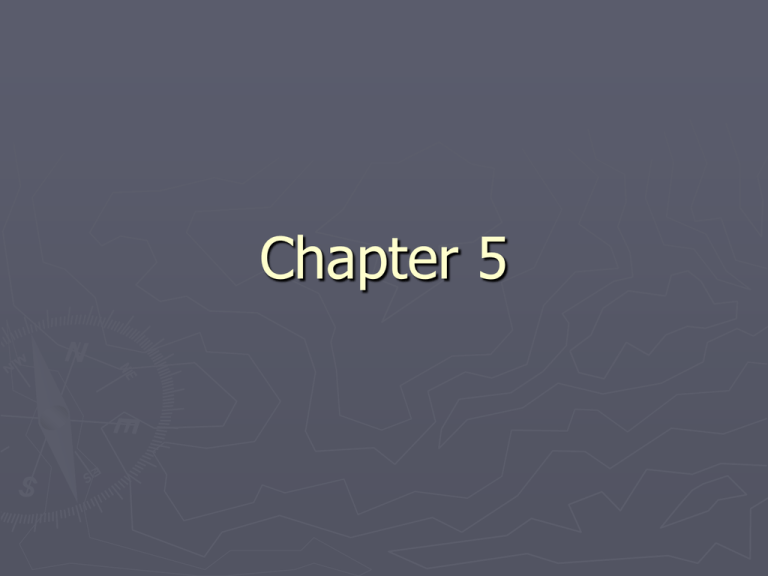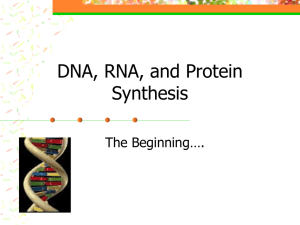Ch 5 Notes - Little Silver Public Schools
advertisement

Chapter 5 5.1 DNA and RNA are required to make proteins ►DNA contains a code – a set of rules or symbols used to carry out the information Stores information that allows a cell to put together the right sequences of amino acids needed to produce specific proteins 5.1 DNA and RNA are required to make proteins ► DNA Structure Shape – double helix Strands – made of alternating sugars and phosphates Rungs – made of nucleotide bases 5.1 DNA and RNA are required to make proteins ► Two bases come together to form a rung ► Adenine pairs with Thymine ► Cytosine pairs with Guanine ► The bases fit together like puzzle pieces ► The order of the bases forms a code for making proteins 5.1 DNA and RNA are required to make proteins ► Replication – Process by which DNA is copied before it condenses into chromosomes Happens before a cell divides 5.1 DNA and RNA are required to make proteins ► Replication – 5.1 DNA and RNA are required to make proteins ► Replication – Process – ►1. two strands of DNA separate, forming a template ►2. nucleotide bases match up and join the open DNA strands ►3. When all open bases are matched up, two new molecules have formed 5.1 DNA and RNA are required to make proteins ► Transcription – Process of transferring DNA to RNA RNA bases pair like puzzle pieces too ►Cytosine ►Adenine pairs with guanine pairs with uracil 5.1 DNA and RNA are required to make proteins ► Transcription – 5.1 DNA and RNA are required to make proteins ► Transcription – DNA is used as a template for RNA ►1. A section of the DNA molecule opens up ►2. Nucleotides of RNA match up and join to the open DNA section ►3. The completed RNA strand is released and moves into the cytoplasm to be translated DNA closes at the end of transcription One strand of RNA is produced 5.1 DNA and RNA are required to make proteins ► Translation – Assembly of amino acids in their proper sequence 5.1 DNA and RNA are required to make proteins ► Translation – ►1. the ribosome attaches to the beginning of a messenger RNA molecule ►2. tRNA molecules carrying an amino acid matches up to a complementary mRNA at the ribosome ►3. ribosome attaches one amino acid to another as it moves along the mRNA molecule ►4. once the amino acids they carry are attached to the chain of amino acids, the tRNA molecules are released ►5. ribosome completes the translation when it reaches the end of the mRNA strand 5.1 DNA and RNA are required to make proteins DNA Is transcribed to make RNA Is translated to form proteins Changes in DNA can produce variation 5.2 • Each human cell and 6 billion base pairs in its DNA ►With such a large number of base pairs, errors can occur ►Errors occur when: • DNA is copied • the environment has an effect ►Mutation ►any change in DNA • Three possible outcomes of a mutation ►Mutation causes no effect ►This is possible because only 5% of the 6 billion base pairs are code for RNA • If the mutation occurs in a non-coding region of DNA, the mutation will most likely not have an effect ►The effect of the mutation is minor ►Example: mutation causes a change in appearance A white American alligator shows a genetic mutation know as leucism. This allele controls migration of pigment cells during development; absence in cells leads to white patches on the skin. ►The effect of the mutation is great ►example: mutation causes a genetic disorder ►Genetic Disorders - ►Disease or condition that results from a mutation • Can • be inherited • Occur during a person’s life ►Example of a genetic disorder • Sickle cell disease ►A recessive genetic disorder which means the person must have two alleles for sickle cell in order to have the disease ►A pedigree is a diagram that shows family relationships including two or more generations 5.3 Modern Genetics Uses DNA Technology ►Changes in organism occur over time because of mutations in DNA ►Random changes may introduce new traits which may become more common over time • This depends on interactions with the environment and each other • Humans also have some control over changes in groups of organisms ►Selective Breeding ►Process of selecting and breeding parent organisms to pass on particular traits to the offspring • In selective breeding, humans are actually taking genes that were already present and making them more common ►Examples ►Horses have become faster • Pigs have gotten leaner • Corn has become sweeter ►In the past 50 years, it has become possible to directly change the DNA of an organism ►Genetic engineering • Process in which a sequence of DNA from an organism is altered • The DNA is isolated, changed, and then returned to the organism or to another organism • Engineered DNA usually codes for a desired trait ►Example: ►Plants being more insect repellent ►Possible Benefits: ►Having more resistant plants increases the food production while decreasing the amount of pesticides needed • Having less chemical pesticides on the ground reduces the risk of environmental pollution ►Possible Risks: ►Affecting natural populations • Scientists genetically modify salmon to grow more quickly • If the genetically modified fish breed with fish from the natural population, the natural population will be ►DNA Technology ►To add nutrients to food • Produce new and better drugs for treating disease • Predict if a drug will have a side effect in an individual • Screen for/treat genetic disorders • Law enforcement such as DNA fingerprinting • Cloning ►Cloning- technique that uses technology to make copies of DNA ►Can be applied to a segment of DNA or a whole organism • Has been used for bacteria to produce proteins and drugs that help fight diseases • Example – insulin is produced in large quantities as a result of cloning techniques







